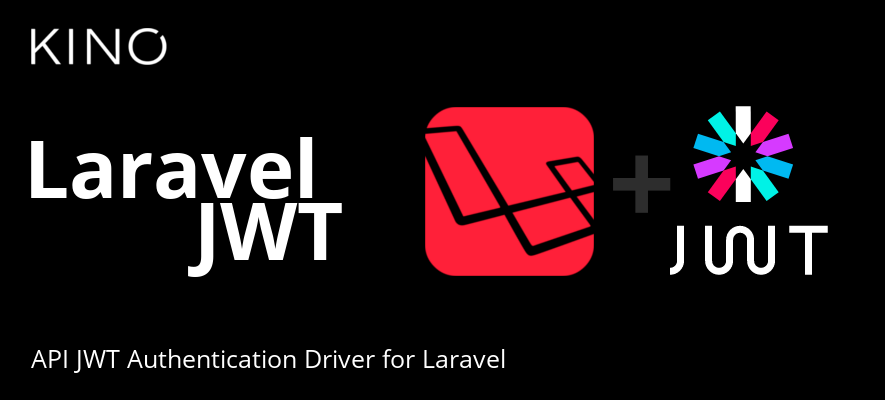dev-master
9999999-devDead simple JWT Auth Provider for Laravel 5.4+
MIT
The Requires
- php >=7.0.0
- ext-openssl *
- lcobucci/jwt ^3.2
- illuminate/support >=5.4.0
by Diego Hernandes
 Wallogit.com
2017 © Pedro Peláez
Wallogit.com
2017 © Pedro Peláez
Dead simple JWT Auth Provider for Laravel 5.4+
 , (*1)
, (*1)
This package provides out-of-the-box API authentication using JWT for Laravel., (*2)
You can install this package by running:, (*3)
composer require kino/laravel-jwt
In order to setup this package into your application, minimal configuration is actually needed., (*4)
Register this package's Service Provider by adding it to the providers
section of your config/app.php file:, (*5)
'providers' => [
// ... other providers omitted
Kino\Auth\JWT\ServiceProvider::class,
],
Publish the configuration file (config/jwt.php) by running the
following command after registering the Service Provider., (*6)
php artisan vendor:publish --provider="Kino\Auth\JWT\ServiceProvider"
In order for this package to works, you will need a separate secret (do not use the application key)., (*7)
This package provides a command that can be used for generating a strong key., (*8)
Get a new key by running:, (*9)
php artisan jwt:generate
Then, copy the generated key contents into your .env file., (*10)
NOTICE: The key generation process will not automatically
set it inside your .env file, do it manually., (*11)
In order to automatically authenticate your routes using JWT tokens,
you need to change the guard driver to jwt, (*12)
Inside config/auth.php set the corresponding guard group you want to protect:, (*13)
If you have the default guard group named api, your auth.php
should be like this:, (*14)
'guards' => [
// ... other guards omitted.
'api' => [
'driver' => 'jwt', // this is the line you need to change.
'provider' => 'users',
],
],
That's it, we are all ready to use it., (*15)
This package aims to be dead simple to use., (*16)
The following templates can be used to setup your existing authentication controllers and resources., (*17)
NOTICE: Full working examples of use for this package will be added on this package when it reaches it's 1.0 version., (*18)
This package is fully integrated with Laravel Authentication., (*19)
The default configuration (config/jwt.php) brings a sensitive value that
is very useful when your application is not completely an API: 'middleware_match, (*20)
By not completely an API, I mean, the JWT guard is not the default one., (*21)
In those cases, in order to use the auth middleware, the config key
middleware_match MUST be set to true., (*22)
This configuration key allows non protected routes to work properly., (*23)
Notice that this option will match middleware group names with guard names., (*24)
In this case, the 'api' middleware group will always use the
apiguard. Also, the 'web' middleware group will always use thewebguard., (*25)
If you do not use this value, you will need to use suffixes when referencing the
auth middleware, like auth:api., (*26)
For issuing tokens, no special class is actually needed, you can just expect create a Guard current implementation from the IoC and work from there., (*27)
Check out the examples., (*28)
** On the following examples, all Guard instances are injected from Illuminate\Contracts\Auth\Guard **
** On the following examples, all Request instances are injected from Illuminate\Http\Request **, (*29)
This method should be used when you just registered a user and any other special cases., (*30)
public function tokenFromUser(Guard $auth) { // generating a token from a given user. $user = SomeUserModel::find(12); // logs in the user $auth->login($user); // get and return a new token $token = $auth->issue(); return $token; }
This method should be used when you just registered a user and any other special cases., (*31)
public function tokenFromCredentials(Guard $auth, Request $request) { // get some credentials $credentials = $request->only(['email', 'password']); if ($auth->attempt($credentials)) { return $token = $auth->issue(); } return ['Invalid Credentials']; }
Tokens can be refreshed in 2 different ways: Auto detect or manual., (*32)
If you do not pass any argument into the refresh method, the Guard will
look for either a Authorization header or a token field on the
request's body., (*33)
public function refreshToken(Guard $auth) { // auto detecting token from request. $token = $auth->refresh(); // manually passing the token to be refreshed. $token = $auth->refresh($oldToken); return $token; }
Of course, there are support for custom claims., (*34)
You can set them in two ways., (*35)
$customClaims = [ 'custom1' => 'value1', 'custom2' => 'value2', ]; // when issuing $auth->issue($customClaims); // when refreshing // custom claims are the second parameter as the first one is the // old token $auth->refresh(null, $customClaims);
If all your users will have the same custom claims, you can setup a default custom claims method on your User's model (or any other Authenticatable you're using):, (*36)
If the method customJWTClaims() is present on the model being issue the token against,
this claims will be automatically included., (*37)
class User extends Model implements Authenticatable { public function customJWTClaims() { return [ 'email' => $this->email, 'name' => $this->name, ]; } }
Dead simple JWT Auth Provider for Laravel 5.4+
MIT